
Wine Culture and Information since 2002 - Volume 22
 Wine Culture and Information since 2002 - Volume 22 |
|
Issue 171, March 2018 |
Contents |
|
|
On the Uselessness of Sensorial Tasting |
|
Don't worry. I have not become crazy or lost my mind, I did not even change my point of view or, better to say, changed the way I am dealing with wine and how I consider it. The premise – I think necessary – is intended to reassure those who, by reading the title above, may have thought of a change of direction or a radical change in this publication I founded sixteen years ago. This is obviously a provocation because – as far as I am concerned – sensorial analysis and organoleptic tasting of wine is essential for understanding it. Not only from an organoleptic point of view, but also from an enological, viticultural and territorial point of view. The same is true, as far as I am concerned and which I certainly support with equal conviction and certainty, for any food or drink: beer, tea, coffee, olive oil, distillates, chocolate, cheese, honey, cooking, food, water and everything capable of giving a sensorial stimulus. The provocation, or better to say, this consideration, arises both from the questions wine lovers ask me about this topic, and from what I read in articles and comments published on the Internet or in some magazines. What surprises me – and, in any case, is surprising me less and less – is the critical opinion expressed by some, those who certainly consider themselves as “experts”, and see sensorial tasting as a useless practice reserved to beginners who obviously understand little or nothing about wine. On the other hand, they consider very competent and expert, telling a wine like a bucolic and rustic journey, a sort of dreamlike experience, which – in my opinion – tells about everything but wine. This may, at the very least, describe the subjective and very personal feelings and emotions a wine can evoke as a result of the tasting and that, as is well known, are strongly influenced by the state of mind, mood and other psychological factors. This is evidently something everyone knows about, however something not known by certain “experts”. Sometimes by reading what this “revered experts” write about wine, gives me sincere hilarity, especially for the intricate exercise of questionable style and the funny terms used. After all, what is a true wine expert if not someone capable of creating a fairy tale richly embellished with bucolic and romantic landscapes, where every sky is blue, boundless and clear, butterflies and bees happily fly on flowers in bloom, every princess makes her love dream come true and get married to the handsome prince? Talking about how much a wine stimulates the tactile perception of astringency and how this relates to the rest, or the analytic sensations perceived from the glass – do not joke about this – is something typical in beginners who know nothing about wine. These ones should be considered like poor ignorant, with the mercy usually shown to those who do not know and – woe is them – have not yet received the enlightenment of the revealed truth, the divine blessing given only to the chosen ones who are shown the Way, the wisdom and the absolute knowledge of Bacchus's secrets. Past, present and future, of course. For these apostles of Bacchus with a casual lexicon, reading that in a wine you can recognize banana, black cherry, almond, violet or clove, is a sacrilege of endless boredom as well as the indisputable sign of incompetence that is typical in beginners, impudent for having dared so much. Who knows what they would say instead, if the aromas of a wine would be described as isoamyl acetate, cinnamic acid, benzaldehyde, alpha-ionone or eugenol. That is by listing the chemical substances determining, in whole or in part, the aromas of the fruits, flowers and spices mentioned above. Anyone can tell a fairy tale, starting from anything – including wine – elaborating and developing every single element, also through metaphors, evocative constructs and rhetorical figures, until reaching the happy end. With the result, at least for me, of having talked about everything but wine: it simply is the story of the emotions and mood of those who have tasted a wine and from this get, by association, an image or a suggestive condition. In other words, it is a story created with the pretext of talking about wine without talking about it at all. These obviously are different ways of describing a wine, then – as always – everyone follows what they feel closest or similar to their culture, interest, objectives, skills and knowledge. Sensorial tasting – and not only of wine – is a discipline requiring concentration, commitment, study, practice, memory, experience, method and technique, to name just a few of the main elements. Above all, it is a discipline in which you never stop learning: every new wine represents – in fact – a world of its own that must be analyzed and understood. Nonetheless, there are no wines that taste the same and each one is different – often very different – from any other. Sometimes, even two bottles of the same wine have sensorial nuances or substantial differences. Of course, it is not a matter of starting from scratch every time a wine is being tasted: experience, memory and technique are always of fundamental help, however never enough. The surprising thing is that the ones who produce wine – wine makers – evaluate the result of their work through sensorial and chemical analysis. Yes, you read it right, even with chemical analysis, that horrible thing – so far away from the world of fairy-tales, unicorns and elves – the one done in a laboratory full of test tubes and chemicals substances. I have the privilege and the pleasure of knowing many wine makers and I have never heard anyone of them defining a wine with intricate, unrealistic tales, using rhetorical figures or an evocative language. Indeed, when I listen to them describing their wines, I hear them talking about methoxypipirazine, aldehydes, fixed acidity, free sulfur dioxide and anthocyanins. As they describe wine like that, could it be the case wine makers are just beginners who do not know anything about wine? I guess this doubt is legitimate, to say the least. They must certainly be subjects that, not being able to do otherwise for obvious incompetence, sometimes make reckless reference to olfactory perceptions – referring to flowers and fruits – just like any inexperienced or unaware beginner. That must certainly be the case. After all, tasting and sensorial evaluation of a wine – real experts say so – is boring and useless. Something to be considered, and with a pitiful compassion, typical in poor beginners who have not yet understood anything about the flights of butterflies in love and wuthering heights. It must necessarily be like that. Antonello Biancalana
|
||||
Contrasts of Asprinio and Moscato GialloDifferent and distant aromas, flavors and structures are the characteristics differentiating the grapes of this month's tasting by contrast |
|
Tasting two different wines with the contrast technique – that is, examining wines produced with very different grapes according to an organoleptic point of view – allows a better understanding of their respective characteristics. The more the two varieties differ from each other in organoleptic terms, the greater the possibility of understanding and highlighting their qualities. The tasting by contrast, however, depends on the goal of the study, because – when this is necessary – this is also done with similar varieties in order to reveal the slightest differences distinguishing them. This is very different, for example, in the case of comparative tasting, that is when two identical varieties or wines belonging to the same style or territory are examined, with the aim of highlighting common characteristics. This also includes vertical and horizontal tasting of wines: the same wine evaluated according to vintage, territory and wine making practices. In this month's tasting by contrast, we will examine two varieties being very different and distant from each other and from every organoleptic aspect, especially in the olfactory and gustatory profiles. The grapes protagonists of this month's tasting by contrast are Asprinio – a typical variety of Aversa, Campania – and Moscato Giallo, typical of Trentino Alto Adige, where it is also known as Goldmuskateller. These two varieties differ, first of all, for their olfactory profiles – Moscato Giallo has appreciable aromatic qualities – as well as for their taste, in which Asprinio has a more intense acidity. We will also find differences in other organoleptic aspects, including structure and roundness. Two very different varieties also according wine making purposes: Asprinio is successfully used for the production of different wine styles – from sparkling to sweet wines – whereas Moscato Giallo is more widely used for making table and sweet wines.
|
|
Asprinio is a variety having particular characteristics, difficult to find in other grapes. The name itself (Asprinio means sourish in Italian) suggests its main quality, that is making sour wines, more precisely, with a marked acidity, a characteristic allowing a rather wide wine making use. This particular characteristic also made this variety interesting for the production of wine distillates. The origins of this variety are not completely clear, it is however certain it is a very ancient grape present in the territory of Caserta – in particular in the Aversa area – since remote times. On this regard, it should be noted that some genetic researches have revealed a certain analogy with Greco di Tufo, a relationship, among the other things, already theorized in the past. In addition to its particular organoleptic qualities, Asprinio is also distinguished by its traditional cultivation technique. This interesting variety is traditionally cultivated with the vite maritata method (Italian for married vine), that is by allowing the vine to climb on a living support, in this case a tree. This particular method of cultivation – very demanding in viticultural terms – is notoriously of Etruscan origin and it is still used today, for example, also in Umbria. The cultivation of the vite maritata requires a completely different skill and technique than the common forms of cultivation, as every intervention – from pruning to harvesting – is done using steep ladders. The vite maritata technique, in fact, provides for the vine to freely climb on the tree, often reaching heights of twenty meters. It should be noted that not all Asprinio is cultivated with this method – more modern forms of cultivation are used as well – but it is proven the best results are obtained with the ancient Etruscan technique of vite maritata. The wines produced with this variety are characterized by their marked acidity, moderate body and absolutely dry taste. The strong acidity and low alcoholic volume of its wines, make Asprinio very appreciated for the production of sparkling wines, both using the classic method and the refermentation in closed tank.
|
||||
|
Variety typically cultivated in Trentino Alto Adige, the origin of the Moscato Giallo actually belongs to very distant lands. This variety is supposed to come from Syria, although some believe this would be a questionable theory. What we know for sure is that Moscato Giallo – thanks to research carried out on its DNA – is a sibling of Muscat Blanc, that is Muscat Blanc à Petit Grains. A bond that, in any case, makes this grape different from the famous relative, something being also evident in its wines, both in terms of aromas and taste. Moscato Giallo is mainly cultivated in the north-east area of Italy, specifically in Trentino Alto Adige, Veneto and Friuli Venezia Giulia. In the territories where it is present, Moscato Giallo is sometimes called with specific names and typical of certain areas: Goldmuskateller in South Tyrol (Alto Adige), Moscato Fior d'Arancio (Orange Blossom Muscat) in the territory of the Colli Euganei in Veneto. The famous Colli Euganei Fior d'Arancio wine is in fact produced with Moscato Giallo and, on this regard, it should be noted in this territory is also cultivated Muscat Blanc grape, used for the production of other wines. From a wine making point of view, Moscato Giallo finds particular use in the production of sweet wines from dried grapes, however it is also well appreciated for the making of table and sparkling wines. From an organoleptic point of view, table wines produced with Moscato Giallo – that is vinified as dry – are characterized by a good aromatic quality and moderate structure, as well as a pleasant crispness. It must also be said dried table wines produced with Moscato Giallo are not particularly suited for a long aging in bottle, a characteristic suggesting – in general terms – the consumption during their youth. A choice, among the other things, allowing the best appreciation of the good aromatic quality of wines produced with Moscato Giallo and that, for this reason, are almost exclusively vinified in inert containers.
|
The wines produced with Asprinio and Moscato Giallo certainly offer the best of their organoleptic qualities within the first few years from harvesting. This means the wines produced with these two varieties are not exactly suitable for the aging in bottle: for this reason it is better to appreciate them during their youth. In both cases, the most commonly used wine making technique for these two varieties – for the production of dry wines – is the use of inert containers, particularly steel tanks. The wines we will examine in our tasting by contrast must be produced with this wine making technique, that is vinified in steel tanks and belonging to the last vintage. We will therefore choose an Asprinio di Aversa – the most significant denomination for this variety – and an Alto Adige Moscato Giallo, which on the label could also be referred to as Südtirol Goldmuskateller. The two wines are served at a temperature of 10 °C (50 °F) in tasting glasses. Let's pour the two wines in their respective glasses and start our tasting by contrast from the evaluation of appearance. The first wine we will consider is Asprinio di Aversa. Tilt the glass over a white surface – for example a sheet of paper – and look at the wine at the base, near the stem. You will notice a brilliant and intense greenish yellow color with a very high transparency. Nuances of Asprinio di Aversa – observed at the edge of the glass towards the opening – also show a greenish-yellow color. Let's now proceed to the evaluation of the aspect of Alto Adige Moscato Giallo, by tilting the glass over the white surface. The color of the wine, observed at the base, is evidently more intense and darker than Asprinio, clearly showing a brilliant straw yellow hue. The shade of Moscato Giallo, observed at the edge of the glass, confirms a straw yellow color. Let's now put the two glasses side by side: the color differences are evident. Asprinio and Moscato Giallo make wines with very different olfactory profiles. The quality of the aromas that can be perceived in their respective wines, in fact, place Asprinio and Moscato Giallo – so to speak – in two opposing and distant positions. Asprinio mainly expresses aromas reminiscent of citrus fruits, in particular lemon, while Moscato Giallo is more clearly placed in the family of aromatic varieties, this is evidently thanks to the relationship with Muscat Blanc. In this variety, in fact, it can be perceived – among the many others – the typical aroma of grape, identifying the so-called aromatic varieties. It is, of course, one of the many olfactory perceptions which can be perceived in this variety, but this is the predominant aroma. In overall terms, Asprinio has decidedly fresher aromas, whereas Moscato Giallo is characterized by rounder and warmer aromas. Let's start the evaluation of the olfactory profiles of the wines of our tasting by contrast by first examining Asprinio di Aversa. Let's keep the glass in vertical position and, without swirling it, evaluate the opening aromas, that is the first ones expressed by the wine. From the glass are perceived pleasant aromas reminiscent of citrus fruits, in particular lemon, as well as pear and apple. Let's now swirl the glass, an operation that will favor the development of the other aromas, and proceed with the second smell. The profile of Asprinio di Aversa is completed with hawthorn, broom, lemon grass, frequently orange, in addition to plum and sometimes almond. Let's now go on and evaluate the opening of Alto Adige Moscato Giallo: from the glass can be perceived pleasing and intense aromas of grape, apple, peach and white rose. After having swirled the glass and done a second smell, the profile of the wine is completed with banana, sage, citrus fruit, apricot, lavender, citrus peel and sometimes, sensations of aromatic herbs, in particular rosemary. The organoleptic differences between Asprinio and Moscato Giallo are also evident in their gustatory profiles. Let's therefore evaluate the attack of the Asprinio di Aversa, that is, the initial sensations produced by the wine at the first sip. In the mouth we can perceive the strong sensation of acidity, practically citrine and directly reminiscent of lemon, as well as perceiving a light structure and an absolutely dry taste. The flavors of lemon, apple and pear are clearly perceptible, in which it is the typical acidity to mainly determine the taste of Asprinio. Let's now take a sip of alto Adige Moscato Giallo and evaluate its attack. This wine reveals a much more moderate acidity than Asprinio, but it is clearly perceptible. Even the structure and roundness are evidently more intense than the previous wine and in the mouth you can perceive the distinct flavor of grape in addition to apple, peach and banana. The final phase of our tasting by contrast is about the evaluation of the sensations the wines leave in the mouth after swallowing, in particular taste-olfactory persistence. The finish of Asprinio di Aversa is of good persistence, leaving in the mouth a strong and intense sensation of acidity and in which it can be clearly recognized a flavor of lemon, as well as apple and pear. The sensation of structure is, even in the final phase, evidently light in addition to an absolutely dry and crisp taste. The finish of Alto Adige Moscato Giallo is persistent leaving a pleasing sensation of roundness in the mouth, much less acidic than Asprinio, with a perception of structure clearly more intense than the previous wine. The flavors of grape, peach and banana are evidently perceived, just like in the gustatory phase. Let's now taste the two wines again, first Asprinio and then Moscato Giallo: the considerable differences in terms of balance between roundness and acidity are evident, as well as the diversity of structure and flavors perceived in the mouth.
|
||||||||
Wines of the Month |
|
|
|
Score legend Prices are to be considered as indicative. Prices may vary according to the country or the shop where wines are bought |

|
|
Solare 2011 |
|
| Capannelle (Tuscany, Italy) | |
 Sangiovese (80%), Malvasia Nera (20%) Sangiovese (80%), Malvasia Nera (20%) | |
| Price: € 48.00 | Score: |
 Brilliant ruby red and nuances of garnet red, moderate transparency. Brilliant ruby red and nuances of garnet red, moderate transparency. Intense, clean, pleasing, refined and elegant, starts with hints of
plum, black cherry and dried violet followed by aromas of blackberry,
blueberry, raspberry, leather, graphite, cocoa, licorice, tobacco, rhubarb,
vanilla and menthol. Intense, clean, pleasing, refined and elegant, starts with hints of
plum, black cherry and dried violet followed by aromas of blackberry,
blueberry, raspberry, leather, graphite, cocoa, licorice, tobacco, rhubarb,
vanilla and menthol.
 Properly tannic attack and however balanced by alcohol, full body,
intense flavors, agreeable. Properly tannic attack and however balanced by alcohol, full body,
intense flavors, agreeable.
 Persistent finish with flavors of plum, black cherry and raspberry. Persistent finish with flavors of plum, black cherry and raspberry. 18 months in barrique. 18 months in barrique. |
|
 Game, Roasted meat, Braised and stewed meat, Hard cheese Game, Roasted meat, Braised and stewed meat, Hard cheese |
|
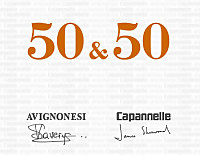
|
|
50 & 50 2013 |
|
| Avignonesi - Capannelle (Tuscany, Italy) | |
 Sangiovese (50%), Merlot (50%) Sangiovese (50%), Merlot (50%) | |
| Price: € 95.00 | Score: |
 Intense ruby red and nuances of garnet red, little transparency. Intense ruby red and nuances of garnet red, little transparency. Intense, clean, pleasing, refined and elegant, starts with hints of
black currant, black cherry and blueberry followed by aromas of violet,
plum, peony, dried rose, chocolate, pink pepper, cinnamon, cardamom,
tobacco, vanilla and eucalyptus. Intense, clean, pleasing, refined and elegant, starts with hints of
black currant, black cherry and blueberry followed by aromas of violet,
plum, peony, dried rose, chocolate, pink pepper, cinnamon, cardamom,
tobacco, vanilla and eucalyptus.
 Properly tannic attack and however balanced by alcohol, full body,
intense flavors, agreeable. Properly tannic attack and however balanced by alcohol, full body,
intense flavors, agreeable.
 Very persistent finish with long flavors of black currant, black cherry
and blueberry. Very persistent finish with long flavors of black currant, black cherry
and blueberry.
 24 months in barrique. 24 months in barrique. |
|
 Game, Roasted meat, Stewed and braised meat, Hard cheese Game, Roasted meat, Stewed and braised meat, Hard cheese |
|
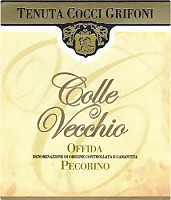
|
|
Offida Pecorino Colle Vecchio 2015 |
|
| Tenuta Cocci Grifoni (Marches, Italy) | |
 Pecorino Pecorino | |
| Price: € 10.00 | Score: |
 Intense straw yellow and nuances of straw yellow, very transparent. Intense straw yellow and nuances of straw yellow, very transparent. Intense, clean, pleasing and refined, starts with hints of apple, plum
and hawthorn followed by aromas of peach, pear, bergamot, chamomile,
pineapple, broom, hazelnut and mineral. Intense, clean, pleasing and refined, starts with hints of apple, plum
and hawthorn followed by aromas of peach, pear, bergamot, chamomile,
pineapple, broom, hazelnut and mineral.
 Crisp attack and however balanced by alcohol, good body, intense
flavors, agreeable. Crisp attack and however balanced by alcohol, good body, intense
flavors, agreeable.
 Persistent finish with flavors of apple, plum and hazelnut. Persistent finish with flavors of apple, plum and hazelnut. 6 months in steel tanks, 12 months in bottle. 6 months in steel tanks, 12 months in bottle. |
|
 Pasta with fish, Mushroom soups, Sauteed white meat, Sauteed fish, Fried fish Pasta with fish, Mushroom soups, Sauteed white meat, Sauteed fish, Fried fish |
|
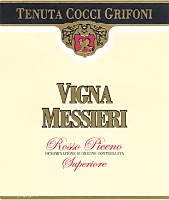
|
|
Rosso Piceno Superiore Vigna Messieri 2011 |
|
| Tenuta Cocci Grifoni (Marches, Italy) | |
 Montepulciano (70%), Sangiovese (30%) Montepulciano (70%), Sangiovese (30%) | |
| Price: € 11.00 | Score: |
 Intense ruby red and nuances of garnet red, little transparency. Intense ruby red and nuances of garnet red, little transparency. Intense, clean, pleasing and refined, starts with hints of plum, black
cherry and dried violet followed by aromas of blackberry, blueberry,
raspberry, leather, tobacco, cocoa, graphite, vanilla and menthol. Intense, clean, pleasing and refined, starts with hints of plum, black
cherry and dried violet followed by aromas of blackberry, blueberry,
raspberry, leather, tobacco, cocoa, graphite, vanilla and menthol.
 Properly tannic attack and however balanced by alcohol, good body,
intense flavors, agreeable. Properly tannic attack and however balanced by alcohol, good body,
intense flavors, agreeable.
 Persistent finish with flavors of plum, black cherry and blackberry. Persistent finish with flavors of plum, black cherry and blackberry. 24 months in cask, 6 months in bottle. 24 months in cask, 6 months in bottle. |
|
 Broiled meat and barbecue, Roasted meat, Stewed and braised meat with mushrooms, Hard cheese Broiled meat and barbecue, Roasted meat, Stewed and braised meat with mushrooms, Hard cheese |
|
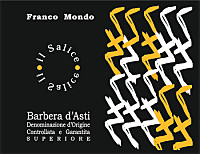
|
|
Barbera d'Asti Vigna del Salice 2014 |
|
| Franco Mondo (Piedmont, Italy) | |
 Barbera Barbera | |
| Price: € 12.00 | Score: |
 Brilliant ruby red and nuances of garnet red, moderate transparency. Brilliant ruby red and nuances of garnet red, moderate transparency. Intense, clean, pleasing and refined, starts with hints of cherry, plum
and raspberry followed by aromas of violet, strawberry, vanilla, tobacco
and cocoa. Intense, clean, pleasing and refined, starts with hints of cherry, plum
and raspberry followed by aromas of violet, strawberry, vanilla, tobacco
and cocoa.
 Properly tannic attack and however balanced by alcohol, good body,
intense flavors, pleasing crispness. Properly tannic attack and however balanced by alcohol, good body,
intense flavors, pleasing crispness.
 Persistent finish with flavors of cherry, plum and raspberry. Persistent finish with flavors of cherry, plum and raspberry. 8 months in cask, 6 months in bottle. 8 months in cask, 6 months in bottle. |
|
 Stuffed pasta, Broiled meat and barbecue, Stewed meat with mushrooms Stuffed pasta, Broiled meat and barbecue, Stewed meat with mushrooms |
|
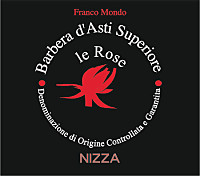
|
|
Barbera d'Asti Superiore Nizza Le Rose 2012 |
|
| Franco Mondo (Piedmont, Italy) | |
 Barbera Barbera | |
| Price: € 22.00 | Score: |
 Intense ruby red and nuances of garnet red, little transparency. Intense ruby red and nuances of garnet red, little transparency. Intense, clean, pleasing and refined, starts with hints of cherry, plum
and dried violet followed by aromas of blueberry, dried rose, blackberry,
cinnamon, cocoa, vanilla and menthol. Intense, clean, pleasing and refined, starts with hints of cherry, plum
and dried violet followed by aromas of blueberry, dried rose, blackberry,
cinnamon, cocoa, vanilla and menthol.
 Properly tannic attack and however balanced by alcohol, good body,
intense flavors, agreeable. Properly tannic attack and however balanced by alcohol, good body,
intense flavors, agreeable.
 Persistent finish with flavors of cherry, plum and blueberry. Persistent finish with flavors of cherry, plum and blueberry. 18 months in barrique. 18 months in barrique. |
|
 Roasted meat, Stewed meat with mushrooms, Hard cheese Roasted meat, Stewed meat with mushrooms, Hard cheese |
|

|
|
Cerasuolo di Vittoria Classico 2014 |
|
| Valle dell'Acate (Sicily, Italy) | |
 Nero d'Avola (60%), Frappato (40%) Nero d'Avola (60%), Frappato (40%) | |
| Price: € 14.00 | Score: |
 Brilliant ruby red and nuances of ruby red, moderate transparency. Brilliant ruby red and nuances of ruby red, moderate transparency. Intense, clean, pleasing and refined, starts with hints of black
cherry, plum and strawberry followed by aromas of blueberry, violet,
blackberry, raspberry, carob, geranium, black pepper and vanilla. Intense, clean, pleasing and refined, starts with hints of black
cherry, plum and strawberry followed by aromas of blueberry, violet,
blackberry, raspberry, carob, geranium, black pepper and vanilla.
 Properly tannic attack and however balanced by alcohol, good body,
intense flavors, agreeable. Properly tannic attack and however balanced by alcohol, good body,
intense flavors, agreeable.
 Persistent finish with flavors of black cherry, plum and strawberry. Persistent finish with flavors of black cherry, plum and strawberry. 12 months in cask, 9 months in bottle. 12 months in cask, 9 months in bottle. |
|
 Stuffed pasta with meat, Roasted meat, Broiled meat and barbecue, Stewed meat with mushrooms Stuffed pasta with meat, Roasted meat, Broiled meat and barbecue, Stewed meat with mushrooms |
|
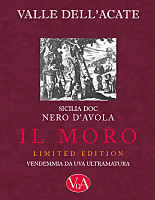
|
|
Il Moro Limited Edition 2015 |
|
| Valle dell'Acate (Sicily, Italy) | |
 Nero d'Avola Nero d'Avola | |
| Price: € 21.00 | Score: |
 Intense ruby red and nuances of garnet red, little transparency. Intense ruby red and nuances of garnet red, little transparency. Intense, clean, pleasing, refined and elegant, starts with hints of
black cherry, blackberry and plum followed by aromas of dried violet,
blueberry, cocoa, pink pepper, carob, tobacco, cinnamon, vanilla and
menthol. Intense, clean, pleasing, refined and elegant, starts with hints of
black cherry, blackberry and plum followed by aromas of dried violet,
blueberry, cocoa, pink pepper, carob, tobacco, cinnamon, vanilla and
menthol.
 Properly tannic attack and however balanced by alcohol, good body,
intense flavors, pleasing roundness. Properly tannic attack and however balanced by alcohol, good body,
intense flavors, pleasing roundness.
 Persistent finish with flavors of black cherry, blackberry and plum. Persistent finish with flavors of black cherry, blackberry and plum. 12 months in barrique, 12 months in bottle. 12 months in barrique, 12 months in bottle. |
|
 Broiled meat and barbecue, Stewed meat with mushrooms, Roasted meat, Hard cheese Broiled meat and barbecue, Stewed meat with mushrooms, Roasted meat, Hard cheese |
|
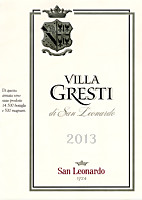
|
|
Villa Gresti 2013 |
|
| Tenuta San Leonardo (Trentino, Italy) | |
 Merlot (90%), Carménère (10%) Merlot (90%), Carménère (10%) | |
| Price: € 23.00 | Score: |
 Intense ruby red and nuances of garnet red, little transparency. Intense ruby red and nuances of garnet red, little transparency. Intense, clean, pleasing, refined and elegant, starts with hints of
black currant, black cherry and plum followed by aromas of violet,
blueberry, raspberry, iris, chocolate, tobacco, pink pepper and vanilla. Intense, clean, pleasing, refined and elegant, starts with hints of
black currant, black cherry and plum followed by aromas of violet,
blueberry, raspberry, iris, chocolate, tobacco, pink pepper and vanilla.
 Properly tannic attack and however balanced by alcohol, good body,
intense flavors, pleasing roundness. Properly tannic attack and however balanced by alcohol, good body,
intense flavors, pleasing roundness.
 Persistent finish with flavors of black currant, black cherry and
blueberry. Persistent finish with flavors of black currant, black cherry and
blueberry.
 14 months in barrique, 12 months in bottle. 14 months in barrique, 12 months in bottle. |
|
 Broiled meat and barbecue, Stewed meat with mushrooms, Roasted meat, Hard cheese Broiled meat and barbecue, Stewed meat with mushrooms, Roasted meat, Hard cheese |
|
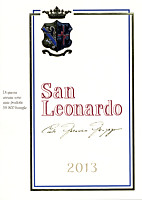
|
|
San Leonardo 2013 |
|
| Tenuta San Leonardo (Trentino, Italy) | |
 Cabernet Sauvignon (60%), Carménère (30%), Merlot (10%) Cabernet Sauvignon (60%), Carménère (30%), Merlot (10%) | |
| Price: € 55.00 | Score: |
 Intense ruby red and nuances of garnet red, little transparency. Intense ruby red and nuances of garnet red, little transparency. Intense, clean, pleasing, refined and elegant, starts with hints of
black currant, plum and black cherry followed by aromas of violet,
blueberry, green bell pepper, raspberry, iris, face powder, chocolate,
tobacco, coriander, pink pepper, vanilla and eucalyptus. Intense, clean, pleasing, refined and elegant, starts with hints of
black currant, plum and black cherry followed by aromas of violet,
blueberry, green bell pepper, raspberry, iris, face powder, chocolate,
tobacco, coriander, pink pepper, vanilla and eucalyptus.
 Tannic attack and however balanced by alcohol, full body, intense
flavors, agreeable. Tannic attack and however balanced by alcohol, full body, intense
flavors, agreeable.
 Very persistent finish with long flavors of black currant, black cherry
and plum. Very persistent finish with long flavors of black currant, black cherry
and plum.
 24 months in barrique, 12 months in bottle. 24 months in barrique, 12 months in bottle. |
|
 Game, Roasted meat, Stewed and braised meat, Hard cheese Game, Roasted meat, Stewed and braised meat, Hard cheese |
|
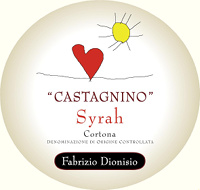
|
|
Cortona Syrah Castagnino 2016 |
|
| Fabrizio Dionisio (Tuscany, Italy) | |
 Syrah Syrah | |
| Price: € 14.00 | Score: |
 Intense ruby red and nuances of purple red, little transparency. Intense ruby red and nuances of purple red, little transparency. Intense, clean, pleasing and refined, starts with hints of black
cherry, plum and black currant followed by aromas of blueberry, green bean,
violet, juniper and black pepper. Intense, clean, pleasing and refined, starts with hints of black
cherry, plum and black currant followed by aromas of blueberry, green bean,
violet, juniper and black pepper.
 Properly tannic attack and however balanced by alcohol, good body,
intense flavors, agreeable. Properly tannic attack and however balanced by alcohol, good body,
intense flavors, agreeable.
 Persistent finish with flavors of black cherry, plum and black currant. Persistent finish with flavors of black cherry, plum and black currant. Aged in cement tanks. Aged in cement tanks. |
|
 Stuffed pasta, Broiled meat and barbecue, Stewed meat with mushrooms Stuffed pasta, Broiled meat and barbecue, Stewed meat with mushrooms |
|
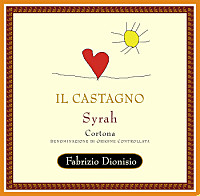
|
|
Cortona Syrah Il Castagno 2014 |
|
| Fabrizio Dionisio (Tuscany, Italy) | |
 Syrah Syrah | |
| Price: € 23.00 | Score: |
 Deep ruby red and nuances of ruby red, little transparency. Deep ruby red and nuances of ruby red, little transparency. Intense, clean, pleasing, refined and elegant, starts with hints of
black currant, black cherry and blueberry followed by aromas of violet,
plum, blackberry, strawberry, chocolate, tobacco, black pepper, vanilla and
eucalyptus. Intense, clean, pleasing, refined and elegant, starts with hints of
black currant, black cherry and blueberry followed by aromas of violet,
plum, blackberry, strawberry, chocolate, tobacco, black pepper, vanilla and
eucalyptus.
 Properly tannic attack and however balanced by alcohol, good body,
intense flavors, agreeable. Properly tannic attack and however balanced by alcohol, good body,
intense flavors, agreeable.
 Persistent finish with flavors of black currant, black cherry and
blueberry. Persistent finish with flavors of black currant, black cherry and
blueberry.
 18 months in barrique. 18 months in barrique. |
|
 Roasted meat, Broiled meat and barbecue, Stewed meat with mushrooms, Cheese Roasted meat, Broiled meat and barbecue, Stewed meat with mushrooms, Cheese |
|
News |
|
In this section are published news and information about events concerning the world of wine and food. Whoever is interested in publishing this kind of information can send us a mail to our address.
|
AquavitaeReview of Grappa, Distillates and Brandy |
|
|
||||||||||||||
Wine Guide ParadeDecember 2017
|
| |||||||
Privacy Policy | |||||||


| Copyright © 2002-2024 Antonello Biancalana, DiWineTaste - All rights reserved |
| All rights reserved under international copyright conventions. No part of this publication and of this WEB site may be
reproduced or utilized in any form or by any means, electronic or mechanical, without permission in writing from DiWineTaste. |